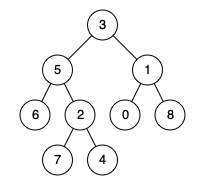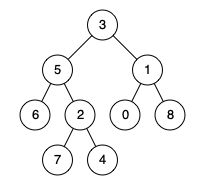Question
Given a binary tree, find the lowest common ancestor (LCA) of two given nodes in the tree.
According to the definition of LCA on Wikipedia: “The lowest common ancestor is defined between two nodes p and q as the lowest node in T that has both p and q as descendants (where we allow a node to be a descendant of itself).”
Example 1:

Input: root = [3,5,1,6,2,0,8,null,null,7,4], p = 5, q = 1
Output: 3
Explanation: The LCA of nodes 5 and 1 is 3.
Algorithm
This is a little bit different with question 235, the tree is a BST and we could utilize the nature of the BST(root is strictly small than it's right and larger than its left).
In this question, the goal is to find a node where the p and q is in its left and right. So the algorithm is like: we traverse all the node in a postorder, and find it left and right result(the result is if there are p or q), if the node left and right are both return values, then this node is the LCA. Otherwise we continue going down to check the node.
At first my code is like
class Solution { public TreeNode lowestCommonAncestor(TreeNode root, TreeNode p, TreeNode q) { if (root == null) return null; if (root.val == p.val || root.val == q.val) return root; TreeNode left = lowestCommonAncestor(root.left, p, q); TreeNode right = lowestCommonAncestor(root.right, p, q); if (left != null && right != null) return root; return null; } }
And I didn't pass the case:
Example 2:

Input: root = [3,5,1,6,2,0,8,null,null,7,4], p = 5, q = 4
Output: 5
The problem here is that for example, if I find 4 under 2, and 7 is not ok, it will return null rather than the node, which is not right. So I changed the code, when there is a p or q, just return it. Then this logic is complete.
Code
/** * Definition for a binary tree node. * public class TreeNode { * int val; * TreeNode left; * TreeNode right; * TreeNode(int x) { val = x; } * } */ class Solution { public TreeNode lowestCommonAncestor(TreeNode root, TreeNode p, TreeNode q) { if (root == null) return null; if (root.val == p.val || root.val == q.val) return root; TreeNode left = lowestCommonAncestor(root.left, p, q); TreeNode right = lowestCommonAncestor(root.right, p, q); if (left != null && right != null) return root; if (left != null) return left; if (right != null) return right; return null; } }